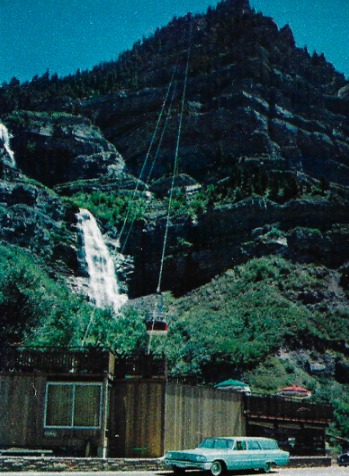The Legend and History of Bridal Veil Falls

Bridal Veil Falls is a gem of Provo Canyon Utah. Its legends remind visitors of tales of love and loss, reminiscent of Romeo and Juliet. Furthermore, its history is connected to the tallest mountain on earth, as well as a record-breaking aerial tramway that made even the most committed daredevils dizzy.
According to a contested Native American legend of dubious origin (see Farmer, 360, 375-77), a girl named Norita fell in love with Grey Eagle, a young man from a rival tribe near Provo Canyon’s Bridal Veil Falls. The couple planned to elope, but Norita was discovered by her elders from both tribes, who told her they had killed her lover. Overwhelmed with grief, Norita leaped from the mountain to join him in the afterlife. Out of compassion for Norita, Mother Nature transformed her hair into “a bridal veil of falling water” and then took Grey Eagle, who had escaped the elders, and “molded his massive frames into the mountain” so that he could watch over Norita forever. Multiple versions of this legend have circulated in the region for decades, and while the veracity of their origin is dubious, they all speak to the mystique and romantic character of Bridal Veil Falls' dramatic vista.
Legends are legends, but in 1977, mountaineer Jeff Lowe hosted an ice climbing seminar at the 607-foot double cataract waterfall. Scott Fischer, famous for his ascents without supplemental oxygen, was in attendance. Fischer broke his ice axe during his ascent, which left him “stranded on a pillar of ice at the height of a ten-story building.” Although he fell to an inevitable death, his friends were shocked to realize he had survived. According to climber Wes Krause, “Scott had reached the bottom of that waterfall at a high rate of speed and then slowed as the ice angled out until he launched off the ramp and out into the rocks.” Fischer sustained minimal wounds, but he continued climbing for nineteen years. In 1996, he perished in the Mount Everest disaster made famous by Jon Krakauer’s book Into Thin Air, which was adapted into the 2015 film Everest, starring Jake Gyllenhaal as Fischer.
Bridal Veil was also well known for its aerial tramway, built in 1961, which carried visitors to the Eagle’s Nest Lodge and Restaurant, perched on a cliff above the falls. Known as “The Sky Ride,” the Swiss-made tramway held the record for being the steepest in the world and was the only tramway to be constructed alongside a major U.S. highway, past a major waterfall, and with a river running directly below it. In the summer of 1993, more than 27,000 people rode the tramway to the Eagle’s Nest. The owner, David Grow, used the property as a “special-event venue for weddings, receptions, and class reunions.” The Eagle’s Nest endured several storms, but most of it was destroyed on New Year’s Day 1996 by an unusually powerful avalanche. Grow wanted to restore the Eagle’s Nest, but a July 2008 fire sealed its fate. Although the falls are beautiful, Bridal Veil’s history speaks of the heartaches, near-death experiences, and losses that it has witnessed.
Images


